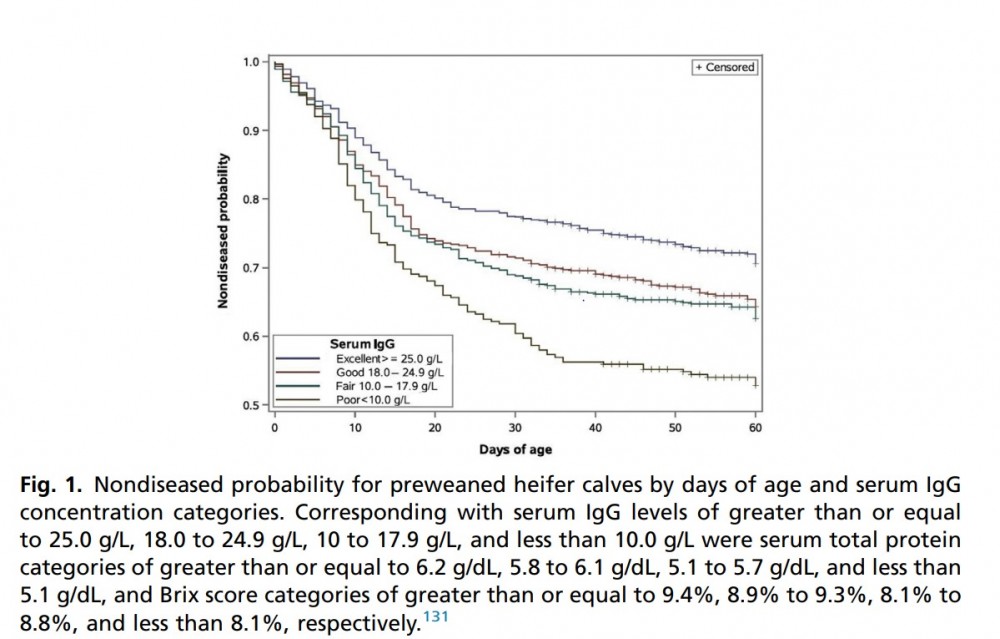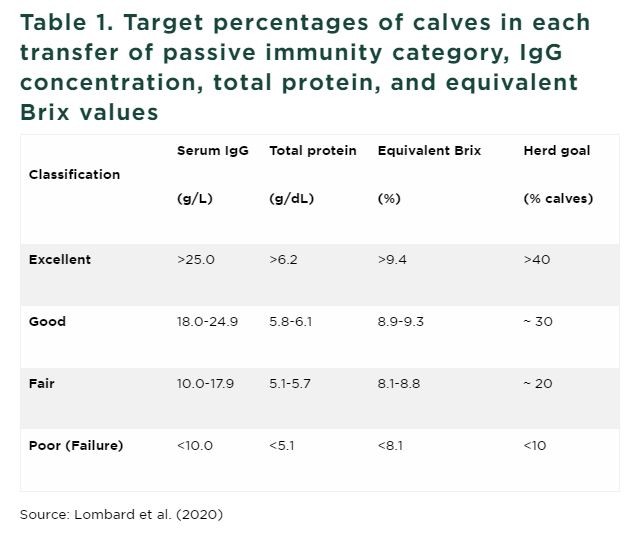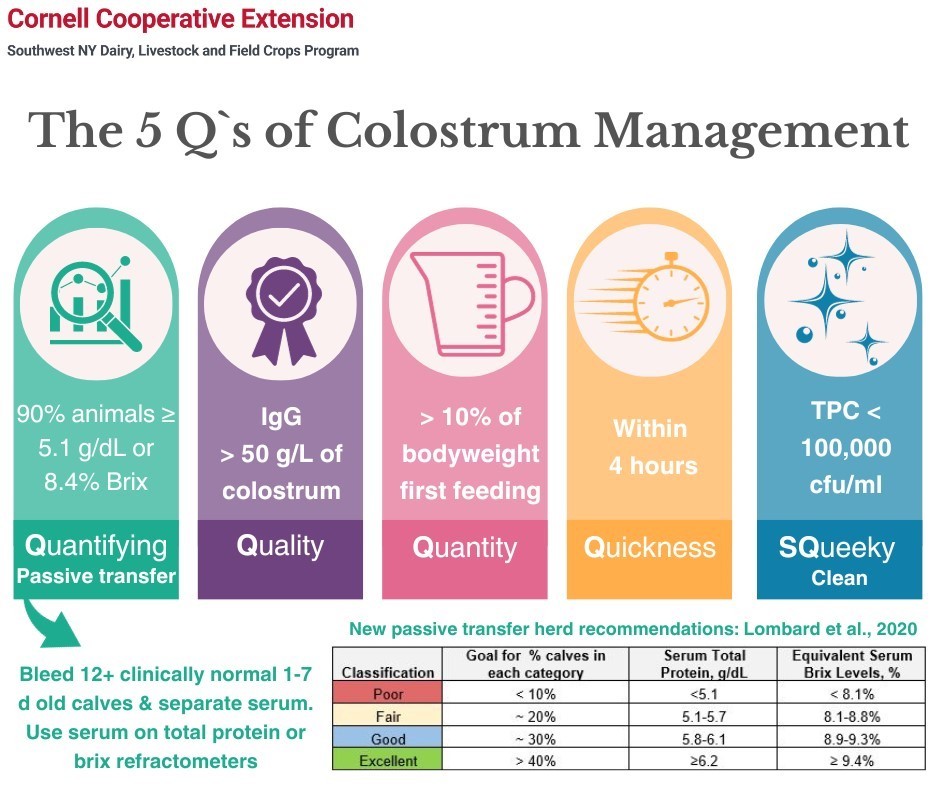The 5Q`S of Colostrum Management
Camila Lage, Dairy Management Specialist
Southwest New York Dairy, Livestock and Field Crops Program
The 5Q`S of Colostrum Management
By Camila Lage, Dairy Management Specialist
Evaluating colostrum management is essential to the heifer program. Colostrum audits can be an alternative to routine monitoring transfer of passive immunity if labor is a constraint to the farm. A snapshot of herd immune status can indicate the farm's current success in colostrum management and suggest whether or not procedures need to be reviewed.
How is it done? - Periodically, blood samples of 14 animals are taken between 2 and 7 days of age, and serum is separated. Total protein is then evaluated using a refractometer, and results are plotted on a spreadsheet.
The latest research from the USDA team, based on the 2014 NAHMS, demonstrated that animals with higher serum total protein values are not just more likely to have lower mortality in the first three months of age but are also less likely to get sick (see figure below) and can recover faster if affected with diseases.
Animals with higher serum total protein values also have improved growth rates and feed efficiency, are more likely to have a decreased age at first calving, and have increased milk production on 1st and 2nd lactations.

Godden et al., 2019
Based on Lombard and colleagues' study, passive immunity should be evaluated at herd levels to maximize calf health, reduce the use of antibiotics, and minimize future performance losses. The target % of animals in each category of total protein is shown in the table below, as suggested by Lombard et al. (2020)

5 Qs of colostrum management
Quantify
- Evaluating farm data routinely or periodically, as done by this project, is essential to keep colostrum management in check. If feasible in your management, routinely evaluate colostrum quality before feeding it to the calves.
- Although an essential source of nutrients and immune factors, colostrum can also represent one of the earliest potential exposures of dairy calves to infectious agents, including Mycoplasma spp, Mycobacterium paratuberculosis, and Salmonella.
- High levels of bacteria in colostrum interfere with IgG absorption, resulting in calves with lower levels of serum total protein. Fresh/raw colostrum fed to calves should contain less than 100,000 colony-forming units (cfu)/mL total plate count (TPC) and less than 10,000 cfu/mL coliform count.
- Producers should avoid feeding colostrum from known infected cows (e.g., Johne disease) and pooling raw colostrum. Contamination during colostrum harvest, storage, or feeding processes can be reduced by properly cleaning and sanitizing udders before harvesting colostrum, milking into a clean, sanitized bucket, and transferring colostrum into clean, sanitized storage or feeding equipment.
- Fresh colostrum should be used within 2 hours of harvest, or refrigerate or freeze stored colostrum ASAP. Refrigerated colostrum must be used within 48 hours. If frozen, it can be used within six months.
Quality
- High-quality colostrum has an IgG concentration of > 50 g/L. Colostrum quality can vary from dam to dam, and cow-side quality testing helps predict IgG concentration. The colostrometer estimates IgG concentration by measuring colostrum density.
- The Brix refractometer also correlates with IgG in colostrum. When using a Brix refractometer to measure colostrum quality, aim to feed colostrum with a Brix reading of at least 22 percent, which equates to an IgG concentration of more than 50 g/L.
- If you need to feed medium to lower-quality colostrum, add a second feeding of 2-3 L 8 hours after birth.
Quantity
- The colostrum volume fed will depend on quality to provide the calf 150-200 g of IgG. The best way to reach this goal is by feeding a larger volume at first feeding (within the first 6 hours after birth).
- For their first feeding, calves should receive at least 10 percent of their body weight in colostrum: approximately 3.9 L (4 qt) for an average-sized calf of ~85 lb.
- Based on the 2014 NAHMS, on average, calves are fed only 2.9 L (3.1 qt) of colostrum at first feeding, which does not meet recommendations
- To increase calves' average serum total protein, consider including a second colostrum feeding of 2-3 L before 8 hours after birth for all animals.
- Remember, to be considered colostrum, it must be the secretion of the first milking.
Quickness
- A calf's ability to absorb antibodies across the gut is optimal in the first hours after birth and declines over time, with a complete closure by 24 hours after birth. The optimal management strategy aims to feed all calves within 1-2 hours after birth and by six as a maximum.
- Taking the calf out of the maternity pen to a clean place before the calf can stand (~ 1 hour after calving) will also ensure calves don't contaminate themselves by sucking in dirty teats or facilities.
sQueaky clean
- Although an essential source of nutrients and immune factors, colostrum can also represent one of the earliest potential exposures of dairy calves to infectious agents, including Mycoplasma spp, Mycobacterium paratuberculosis, and Salmonella.
- High levels of bacteria in colostrum interfere with IgG absorption, resulting in calves with lower levels of serum total protein. Fresh/raw colostrum fed to calves should contain less than 100,000 colony-forming units (cfu)/mL total plate count (TPC) and less than 10,000 cfu/mL coliform count.
- Producers should avoid feeding colostrum from known infected cows (e.g., Johne disease) and pooling raw colostrum. Contamination during colostrum harvest, storage, or feeding processes can be reduced by properly cleaning and sanitizing udders before harvesting colostrum, milking into a clean, sanitized bucket, and transferring colostrum into clean, sanitized storage or feeding equipment.
- Fresh colostrum should be used within 2 hours of harvest or refrigerate or freeze stored colostrum ASAP. Refrigerated colostrum must be used within 48 hours. If frozen, it can be used within six months.
If you want to talk about your colostrum management, please feel free to reach out to Camila at 607-422-6788 or cd546@cornell.edu
References:
Godden, S.M., Lombard, J.E. and Woolums, A.R., 2019. Colostrum management for dairy calves. Veterinary Clinics: Food Animal Practice, 35(3), pp.535-556.
Lombard, J., Urie, N., Garry, F., Godden, S., Quigley, J., Earleywine, T., McGuirk, S., Moore, D., Branan, M., Chamorro, M. and Smith, G., 2020. Consensus recommendations on calf-and herd-level passive immunity in dairy calves in the United States. Journal of dairy science, 103(8), pp.7611-7624.

Upcoming Events
WNY Pastureland Conversion & Soil Health Field Day
July 16, 2025
Middleport, NY
Join American Farmland Trust for the Western New York Soil Health Field Day on July 16, 2025, at Zeliff Farm in Middleport, NY, from 9:00 AM-3:15 PM. Learn about pasture conversion, soil health benchmarking, biochar in grazing systems, and best grazing practices. Plus, enjoy hands-on demos with the NY Soil Health Trailer, drones, and cover crops! Check out the attached agenda for more information about the field day and REGISTER HERE. Zeliff Farms is a regenerative beef operation who has recently partnered with AFT on outreach and education to farmers including learning circles and evaluating biochar effects on soil health.
IPM Strategies to Protect Corn and Soybean Seed in NY
July 30, 2025
Hamburg , NY
SWNYDLFC and Cornell IPM are hosting a grower meeting to discuss integrated pest management strategies for protecting corn and soybean seed in New York.
FAMACHA Training for Sheep and Goat producers in Woodhull NY
August 13, 2025 : FAMACHA Training in Woodhull
Woodhull, NY
Join us for a discussion and hands-on training for internal parasite integrated pest management in sheep and goats. Certification is available to all students participating in the workshop.
Announcements
No announcements at this time.





